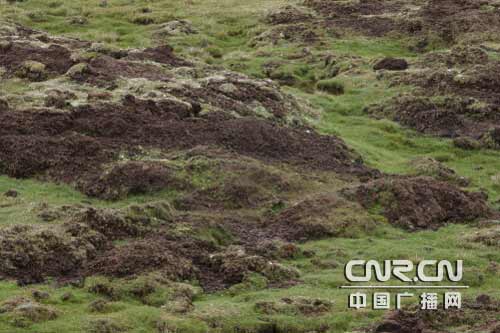Gophers rampant, grassland degraded
In the 1970s, Maduo County was renowned for its natural beauty. 8,000 herdsmen raised up to 800,000 yaks and sheep, with their per capita income reaching 500 yuan. It might have been the richest county in China. However, due to grassland degradation, the per capita income of Maduo County has fallen almost to last place. It is now one of the poorest counties in the country.
|

|
|
Photo showing degraded grassland in Sanjiangyuan.
|
Dongba told Guangzhou Daily that ten years ago his family raised more than 800 yaks and sheep, and most of villagers were as wealthy as him. Now everything has changed. With less grassland available, fewer yaks and sheep are raised.
Now in the Sanjiangyuan area, where there is turf there are gopher holes. The gophers have no fear of humans at all.
According to Dongba, who lives at the pass of Bayankala Snow Mountain, it was once covered with grass almost 50 centimeters high; now, however, there is only short turf growing close to the ground. "Nowadays, gophers on the grassland are our biggest headache. As they eat up the grass, there is nothing left to feed our yaks and sheep."
"The fight between humans and gophers continues," said Sangjie Cairang, head of the Grassland Supervision and Administration Station of the Animal Husbandry Bureau in Maduo County, "We are making efforts to cut down the damage caused by gophers."
According to him, biological poisons have been used on 1.67 million hectares of grassland to kill gophers since 2006. Starting this year, aeries will be built on 270,000 hectares of grassland to attract hawks, since each hawk can catch as many as 80 gophers every day.
Another big problem - no sewage treatment plant
With an increasing local population and more visitors to Sanjiangyuan, sewage and garbage discharge is also threatening its environment.
Sanjiangyuan covers an area of 238,000 square kilometers within the Yushu Tibetan Autonomous Prefecture. Shockingly, due to lack of funds there is no decent sewage or garbage treatment plant in such a critical area. Sewage is discharged directly into nearby rivers, and flows into the Tongtian River, then the Yangtze River.